‘History is the warm, vital, progressive setting forth of the doings of live people’ Suzy Swift, U.S. Salvation Army
Please also look at my historical fiction titles.
Copies of most of these publications are available from me, please contact me for further details. If this email address bounces, or if you do not get a reply within 48 hours, please keep trying, it should work! The books are also available directly from the publishers and some are on Amazon (follow the links in the titles) however I am always keen to reclaim the space in my house and sell directly; this also means that you get a signed copy and a few more pennies find their way into my piggy bank.
Tracing your Marginalised Ancestors: a guide for family historians (Pen and Sword 2024)
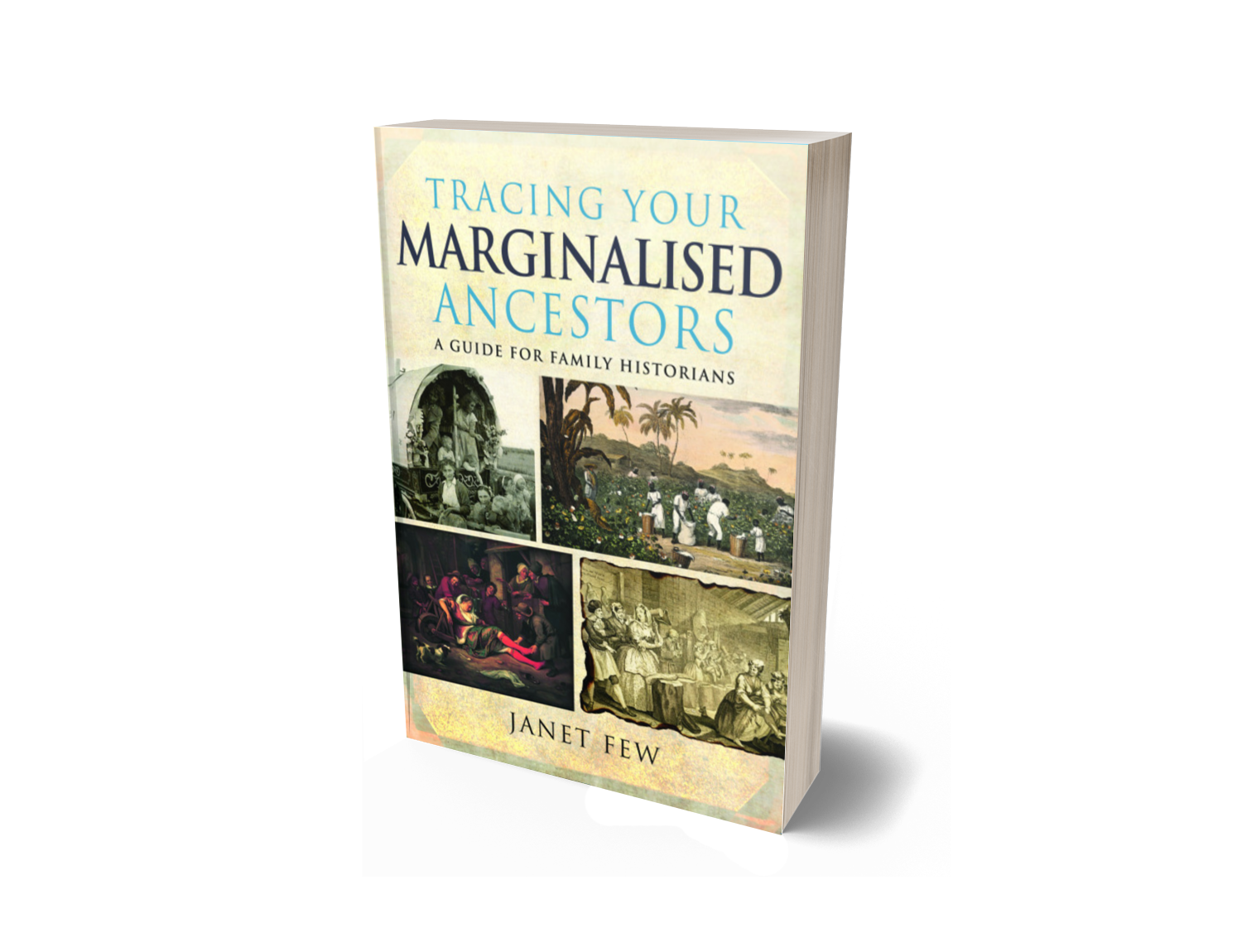
Often, our most fascinating ancestors are those on society’s margins. They might have been discriminated against due to personal misfortune, or have been a victim of society’s fear of difference. You may have ancestors who were poor, or sick, illegitimate, or lawbreakers. Were your family stigmatised because of their ethnicity? Perhaps they struggled with alcoholism, were prostitutes, or were accused of witchcraft. This book will help you find out more about them and the times in which they lived.
The nature of this book means that it deals with subjects that can make uncomfortable reading but it is important to confront these issues, as we try to understand our ancestors and the society that led to them becoming marginalised. Here you will find plenty of suggestions to help you uncover the stories of these, often elusive, groups of people. Will you accept the challenge to seek out your marginalised ancestors and tell their stories?
Coffers, Clysters, Comfrey and Coifs: the lives of our seventeenth century ancestors
*I am currently selling this for £5 including postage to a UK address, if you contact me*
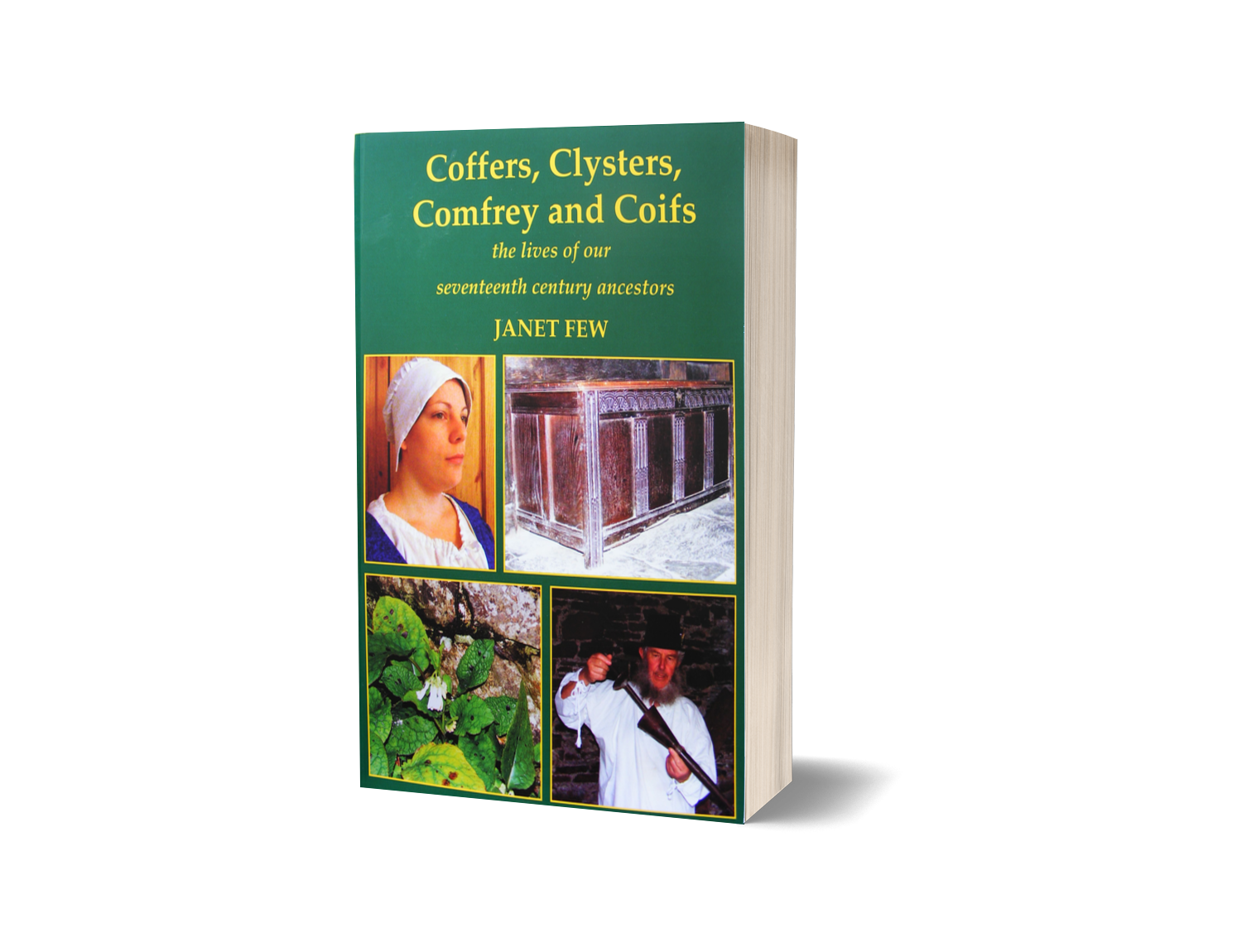
Our seventeenth century ancestors may be people that we can identify, or they may be lurking, nameless, waiting to be discovered. In either case they existed, therefore we owe it to them to find out more about their way of life. This book sets out to provide an all-important context for these ancestors, ancestors whose detailed biographies probably elude us. The book makes good use of contemporary documents to put together an overview of life in the time of the Stuarts, concentrating on the lives of ‘ordinary’ folk, rather than the aristocracy.
Here you can discover what those Jacobean ancestors would have worn, what they would have eaten and how they would have lived. There is a chapter on medical practices and one on the medicinal use of herbs, complete with handy ‘cures’. Next time you are suffering from plague or a pain in the head you will know where to turn. Other sections cover gardens, crime and punishment, witchcraft, leisure and festivals.
The book is fully indexed and lavishly illustrated with photographs and contemporary engravings. There are also extracts from seventeenth century books offering recipes and household hints.
Throughout the book are explanations of phrases such as ‘humble pie’ or ‘sleep tight’. You can learn who was straight laced and why, how to roast a calf’s head and how to bleach linen. Having read this book, it is possible to appreciate the mental and physical demands of the housewife’s role. What also comes across is how hardworking and versatile our Jacobean ancestors had to be.
Few, Janet Coffers, Clysters, Comfrey and Coifs: the lives of our seventeenth century ancestors The Family History Partnership (2012) 247mm x 173mm paperback £12.95 ISBN: 978-1906280338
‘The Family History Partnership’s latest publication is Janet Few’s Coffers, Clysters, Comfrey and Coifs, and it’s a bit of a gem. … Each [chapter] is packed with anecdotes and moments to make you think ‘Oh that’s where that comes from!’ – the window originally being the ‘wind-eye’, to allow air and light in, the ‘chairman of the board’ originally being the person who sat at the chair on the end of the table or ‘board’, and so on. … This is the first book I’ve read to tell me about the roll of the ‘piss prophet’, a job that makes me extremely grateful that I have taken the career route that I have! Each chapter is not only beautifully illustrated in colour throughout, but also ends with a further reading list to take your understanding of the topic in question further.’ Chris Paton – British Genes
‘It is a book that can be dipped into for reference or read cover to cover: a most enjoyable and interesting read and a must for the family historian.’ Cornwall Family History Society Journal
‘Janet’s book, as to be expected, is exceptionally well researched, easy to read, yet packed with information. It is nicely illustrated with modern colour photographs and black and white woodcuts. A nice touch is the use of inset quotes from contemporary sources, which add so much to the book without interrupting the flow of the text. If you’ve ever wondered what a ‘Bilbo’ is, wanted to make fritters of sheep’s feet or puzzled over that dried stag’s penis that has been handed down through the generations, then this is, most definitely, the book for you.’ Isle of Wight Family History Society Journal
‘For those of us fortunate enough to have traced our ancestors back to the 1600s, this book is a “must have”. …. The subjects covered range from household furniture and equipment to cooking, clothing, childbirth, crime and cures for all ills. The alliterative chapter headings make you want to reach for a dictionary – until you realise that all is revealed within the detailed text. How many of you have heard of clysters, jumbles, bum rolls or bilbos?’ Devon Family Historian
‘Whether you like to read a book cover to cover, or dip into random chapters, this book presents a rich flavour and a well balanced portrait of seventeenth century life. You will find yourself stepping into the boots or clogs of our Stuart ancestors and walking in their footsteps. Coffers, Clysters, Comfrey and Coifs is a book that has been well written from an amazing wealth and depth of research and knowledge. It is easy and pleasurable to read and I whole-heartedly recommend it to all readers, male and female, of any age. It will both entertain you and leave you feeling well-informed.’ C.E.
‘This is a book that works on several levels. It is a good read if you wish to sit and immerse yourself in the day to day experiences, chores, and challenges that faced our ancestors in the seventeenth century. It wears its scholarly research lightly and manages to impart information in a lively and interesting way. It is also a good reference book; use the contents page in conjunction with the index. From birthing to cause of death, via crime and punishment, food and clothing and the never ending cycle of a woman’s work; it is all here. As a book to dip into it also scores. Found a will listing medical paraphernalia? Look at Chapter 6 – and never complain again about the modern NHS! Visiting a seventeenth century building – how did they live here? Chapters 1 and 5 (homes and furnishings & gardens and gardening) provide the answers.’ D.G.
Ten Steps to a One-Place Study
By Dr Janet Few
Available as a paperback or ebook
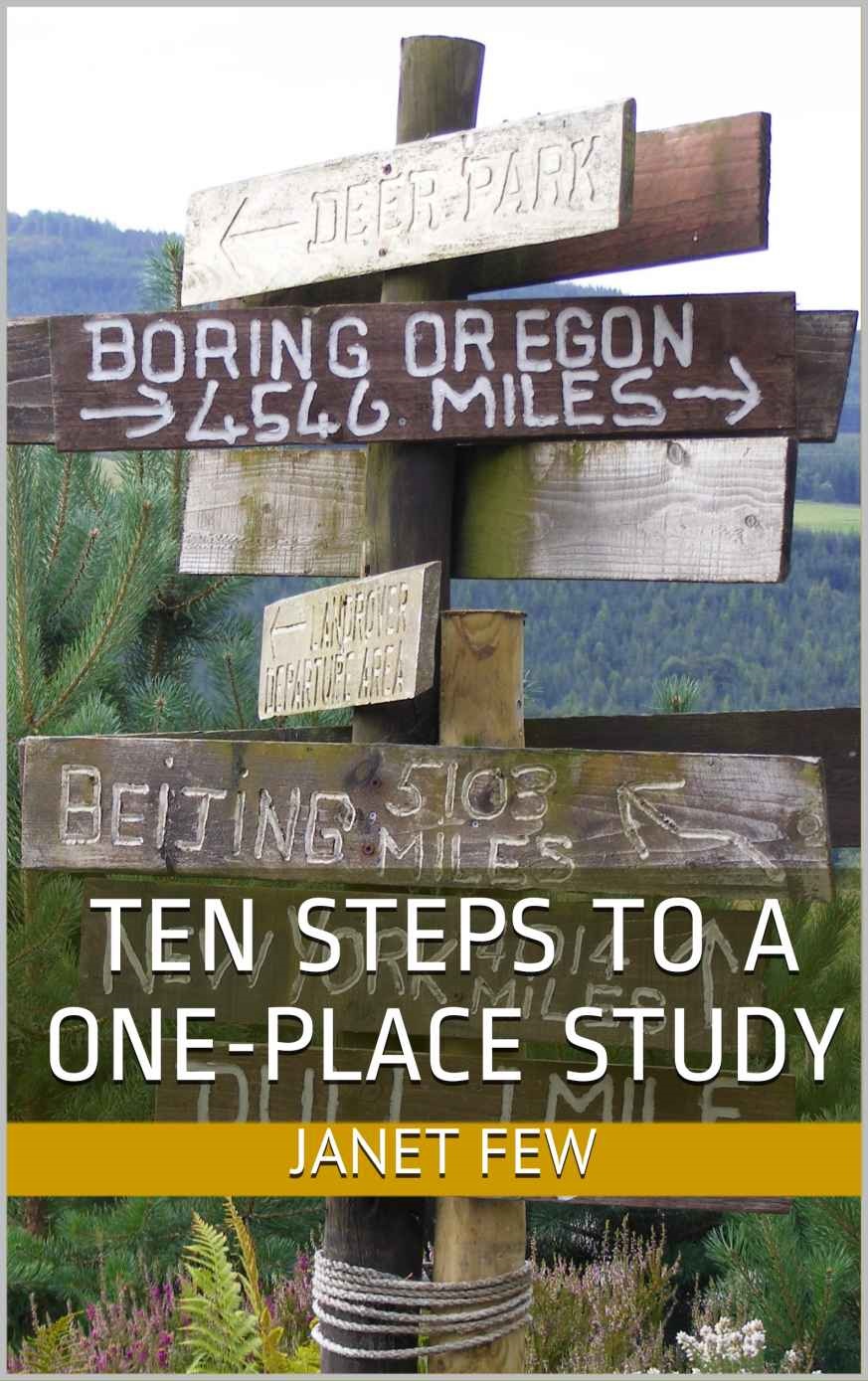
One-place studies are a fascinating blend of family history and local history. This form of micro-research is becoming increasingly popular amongst genealogists and local historians. A one-place study involves investigating a small geographical area in minute detail, researching the inhabitants, the buildings and the institutions within that place, as well as the events that took place there. This booklet is an introductory guide for those who are just starting on their one-place journey and for more experienced one-placers who would like direction or inspiration, or who are seeking a more organised approach to their study.
Few, Janet Ten Steps to a One-Place Study Blue Poppy Publishing (2020) 210mm x 148mm paperback 52 pages £5.00 ISBN: 978 1 911438 18 2
‘An essential purchase if you’re considering starting a One-Place Study – or if you simply want to know more about what it would entail.’ Peter Calver – Lost Cousins
Remember Then: women’s memories of 1946-1969 and how to write your own
By Dr Janet Few
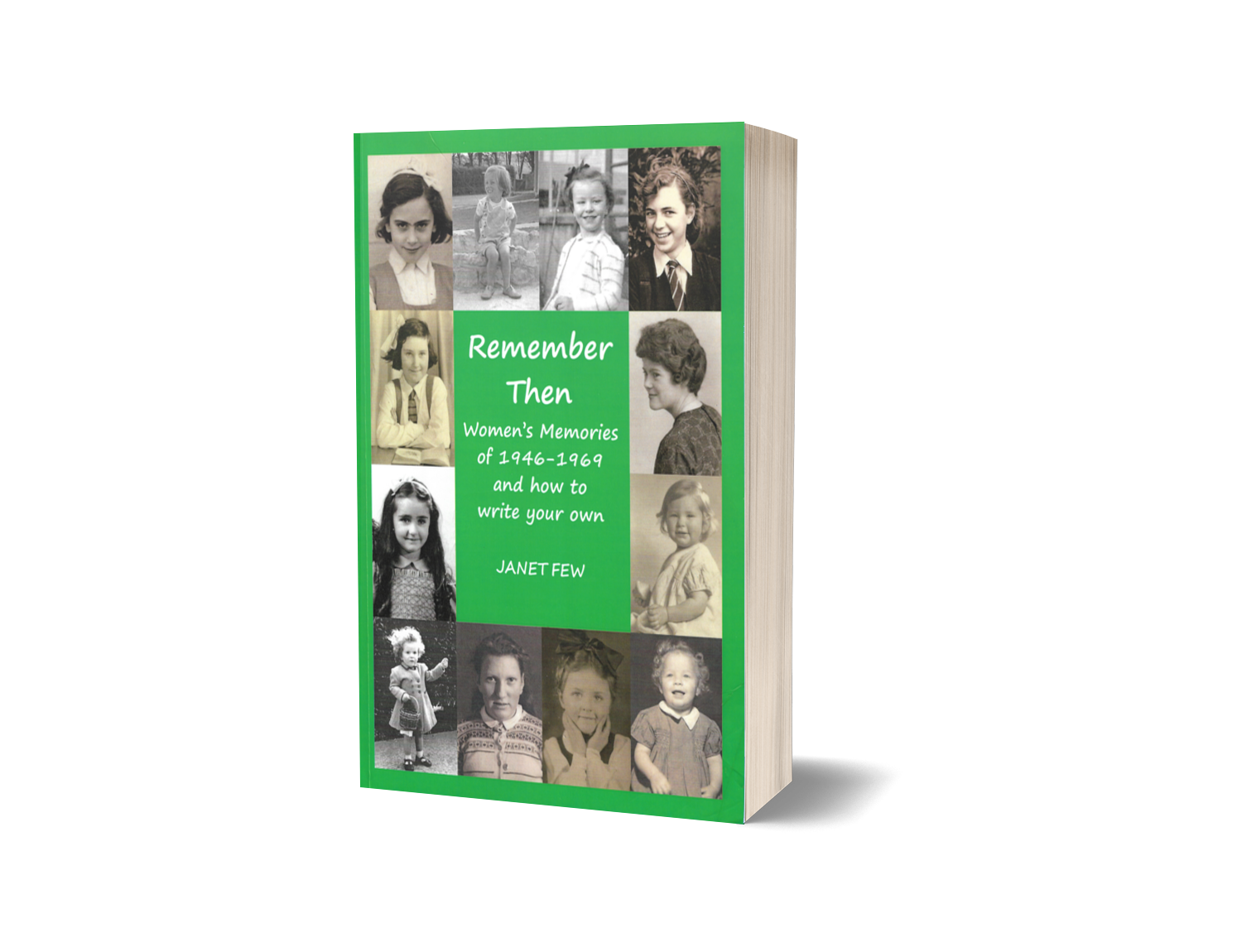
This book is what happens when you let eighty women spend a year and a half recording their memories of life in Britain throughout the pivotal period 1946-1969. This twenty four years was one of tremendous change in almost every area that they investigated. During this time, we moved from liberty bodices to mini skirts and from ration books to ready meals. We witnessed the emergence of youth culture, the comprehensive education system, conspicuous consumerism and a new wave of feminism; the Britain of 1969, was very different to that of 1946.
Very little additional research has been done, the women’s voices have been allowed to speak for themselves. Memories are just that and sometimes memory is fallible. Efforts have been made to check dates and facts but for the most part, the ladies’ accounts have been taken at face value. The aim was not to write a comprehensive social history but to give a flavour of the period from the view-point of those who lived through it. Even reading the first names of the participants takes you back to the classrooms of the 1950s.
The ladies described their homes and neighbourhoods, clothes, housework and food, education and work, health and childrearing, leisure and celebrations, as well as tackling more emotive subjects, such as relationships and attitudes. Over a hundred illustrations and a comprehensive timeline of events evoke the essence of the era. This book is much more than just a collection of women’s memories. At the end of each chapter is the brief that the volunteers were given when working on that topic. This can be applied to other time frames and will help the reader, male or female, to write reminiscences of their own.
The women who took part came from a variety of social, economic and geographic backgrounds. Some ladies went to boarding schools, some to grammar schools and others to secondary moderns. Some left school at fourteen, others have PhDs. Some are only children, others had large extended families and some grew up in care. The ladies were aged from 59 to 95, so some experienced this era as children, some as teenagers and others as married women with families. I wove together the words of this disparate group of volunteers, using direct quotations from their reminiscences wherever possible, to reveal this period, as seen through their eyes. The result is a many faceted perspective of life at the time.
The book allows those born after 1969 to gain an understanding of what life was like for earlier generations. This makes it valuable reading for those working with older people, as it can spark conversations and help to awaken memories. If you lived through this era yourself, you will find yourself exclaiming, ‘I remember that!’ on every page.
Few, Janet Remember Then: women’s memories of 1946-1969 and how to write your own The Family History Partnership (2015) 247mm x 172mm paperback 246 pages £12.95 ISBN: 978 1 906280 53 6
‘I even love the feel of the book for some reason. I’m in a real nostalgic place at the moment so this book is so perfect for me right now. It’s the very book I would like to have written.’ M.P.
‘It’s brilliant, have just spent an hour and a half sort of speed reading to get a flavour and look forward to digesting it more slowly. You’ve done a great job and it certainly sounds like a cohesive voice, not a disparate set of reminiscences, fantastic.’ M.T.
‘You have done a fantastic job. I have laughed and cried reading all the memories. It just transports me back to that period. It has stimulated me to continue to work on my own memories and given me ideas of how to improve them.’ M.W.
The Family Historian’s Enquire Within shortlisted for a Chartered Institute of Library and Information Professionals award.
Updated by Dr Janet Few
*I no longer have any stock left of The Family Historian’s Enquire Within – please try the Family History Federation Shop*
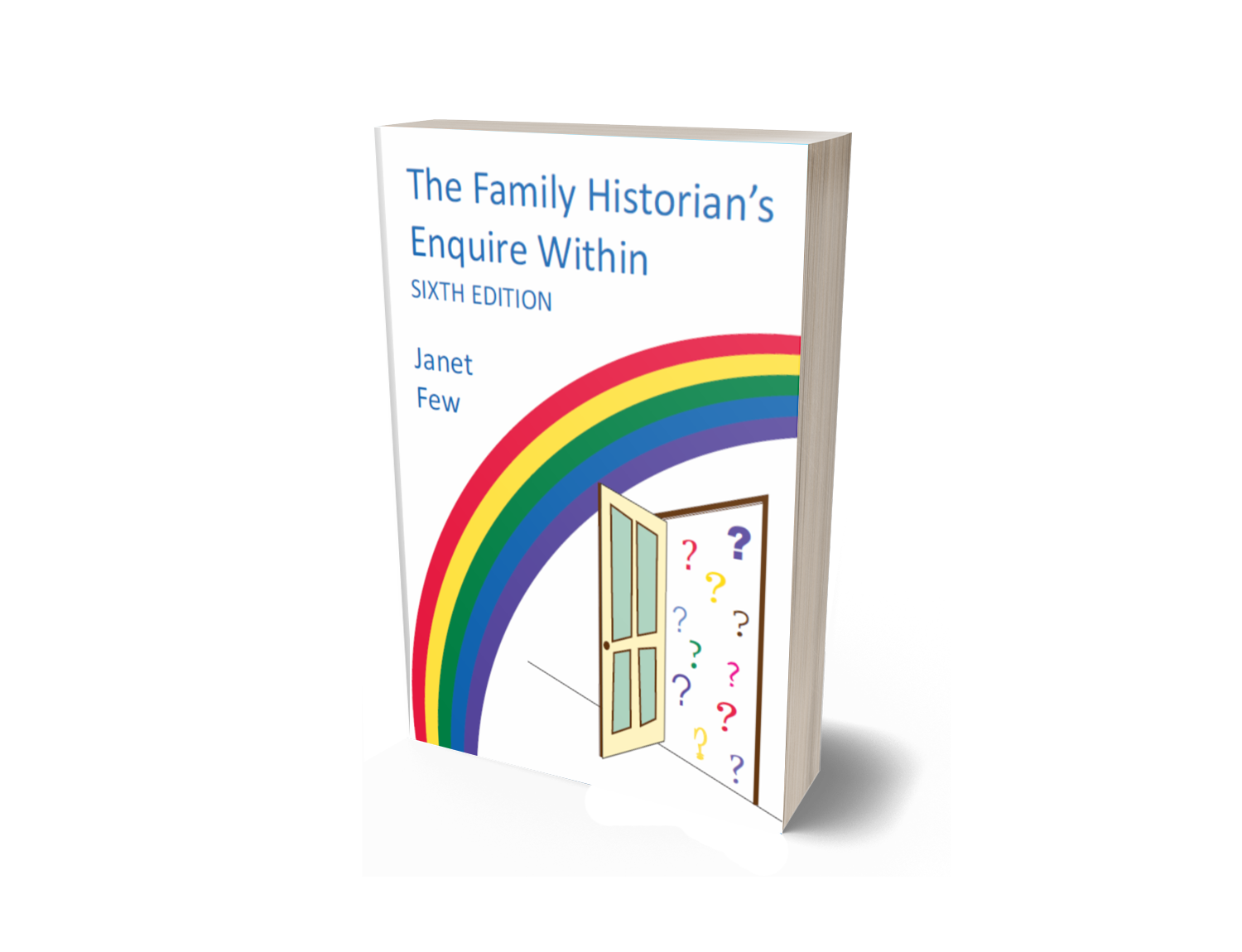
The last edition of this book was published in 1995. Since then, family history research has changed beyond all recognition, not least because of the internet. It is a tribute to the volume’s usefulness that, despite the many innovations since it was produced, the last edition was still the one book I would turn to when asked to man a family history ‘help desk’. An update was long overdue and I am honoured to have been involved in such a family history classic.
This book is not designed to tell you everything you need to know. Instead, its purpose is to point you in the right direction, so you can find out more. The number of people who have been involved in this and earlier, editions means that the entries are wide ranging and have a variety of regional slants. We have aimed to be as comprehensive as possible but inevitably, there will be topics that some feel are missing. We hope however that we have covered everything that most family historians will require. Equally, in the fast moving world that is family history of the C21st, new books and websites will be appearing all the time. We have endeavoured to be up to date and indeed additions were still being made to the ‘A’ entries as we worked our way through later letters of the alphabet.
Few, Janet Family Historian’s Enquire Within The Family History Partnership (2014) 248mm x 172mm paperback 296 pages £12.95 ISBN: 978-1906280116
‘It should be on every serious family historian’s bookshelf’ R.R.
‘This is one of the most generally useful genealogical books on the market. In dictionary format, it provides clear sign-posts to point you in the right direction at every stage in your research.’ David Gilligan
‘If you only have one Family History reference book on your shelf, this is the one you need’ Pharos Tutors’ Newsletter
Putting your Ancestors in their Place: a guide to one place studies
*I no longer have any stock left of Putting your Ancestors in their Place please try the Family History Federation Shop*
By Dr Janet Few
A One Place Study involves dissecting a small, definable, geographical area, to examine the individuals, buildings and processes of the past, in as much detail as possible. Our ancestors did not live in isolation. Family historians often focus on the nuclear family. Local historians might concern themselves with events, buildings and famous residents. To better understand our ancestors, they need to be ‘put in their place’, by investigating the community of which they were a part. To bring the history of a locality to life, it should be populated with ordinary people. A One Place Study brings family and local history together, to the benefit of both fields.
Ranging from how to choose your place, through locating sources and collating your data, to publishing your findings; this book is suitable for experienced researchers as well as those new to One Place Studies. Elements that a One Place Study might incorporate and sources that could be used, are explained in this book. Although sources are described, it is not primarily about the sources themselves. The emphasis is on how these records might be used and projects that the one place researcher might undertake.
One Place Studies are not just about indexing documents and collecting data. Ultimately they are about using that data to answer questions about a community, its residents and their lives. They are about making connections, between individuals, between inhabitants and locations and between people, places and events. In this way, it is possible to gain an insight into the lives of past residents and shed light on issues such as household composition, occupational structure, migration patterns and residential persistence. This book suggests some of the ways in which this might be done.
Few, Janet Putting Your Ancestors in their Place: a guide to one place studies The Family History Partnership (2014) 210mm x 148mm paperback 96 pages £7.95 ISBN: 978-1906280437
‘It’s Marvellous!’ P.S. (on Twitter)
‘This is a good grounding for those undertaking One Place Studies anywhere. The resources are obviously aimed at those within England and Wales, but that itself can give rise to contemplation of what similar records exist in your location where ever you or your study are in the world. I personally recommend this thoroughly researched and comprehensive guide to anyone who has an interest in understanding the places in which their ancestors lived.’ Julie Goucher
Harnessing the Facebook Generation: ideas for involving young people in family history and heritage
By Dr Janet Few
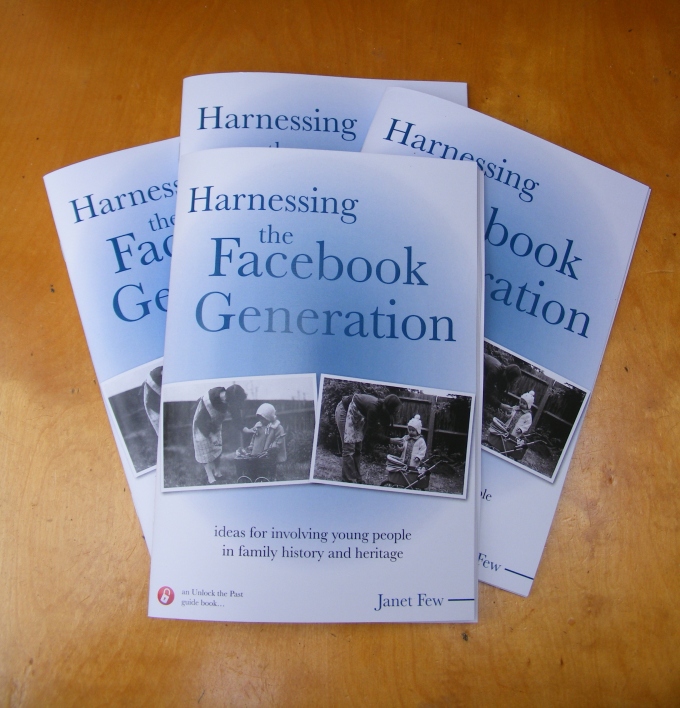
Despite its title, this book is not about how to set up a Facebook page, how to Tweet, or how to create a website. Instead, it is about ensuring a future for our research. It is about why we should be concerned about doing this and how we can go about making sure that our family’s history is not only preserved but enhanced when we are no longer able to be its custodian. It is also about presenting our hobby in a way that is attractive to all age groups. This is a book for grown-ups who want to inspire their descendants and other young people, with a love of history and heritage. It is a thought-provoking look at how we can encourage the next generation of family historians and why we might want to do so. Suggestions cover activities, outings, toys, games, books and ways of exploiting the internet in order to motivate and enthuse young people, even toddlers.
Available from the publishers or as an ebook. It is also available via UK and Canadian outlets.
The Ones that got Away: tracing elusive ancestors who move into, out from and within Britain
By Dr Janet Few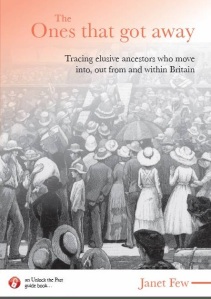 Sooner or later, all genealogists encounter elusive family members: those who appear as if from nowhere; those who disappear without trace and those who vanish for a long period, only to re-emerge later. Ancestors who lurk, parentless, in the top branches of your family tree, or who are apparently still alive at the age of one hundred and sixty are likely to be migrants. This book describes many research paths that you can follow and sources that you can consult, in your quest for that migrant ancestor. If you are successful, you will have found a new piece of the jigsaw puzzle that is your family’s history. Unfortunately, there is no ‘magic wand’ but adopting a problem-solving approach and following the many suggestions in this book, may help to break down the brick walls that mobile ancestors often leave in their wake.
Sooner or later, all genealogists encounter elusive family members: those who appear as if from nowhere; those who disappear without trace and those who vanish for a long period, only to re-emerge later. Ancestors who lurk, parentless, in the top branches of your family tree, or who are apparently still alive at the age of one hundred and sixty are likely to be migrants. This book describes many research paths that you can follow and sources that you can consult, in your quest for that migrant ancestor. If you are successful, you will have found a new piece of the jigsaw puzzle that is your family’s history. Unfortunately, there is no ‘magic wand’ but adopting a problem-solving approach and following the many suggestions in this book, may help to break down the brick walls that mobile ancestors often leave in their wake.
Although it involves work, seeking out migrant ancestors is worthwhile; they often have the most interesting stories to uncover. In this volume, you will find advice for locating missing vital records for British family members and advice for those seeking immigrant and emigrant ancestors. There are also lists of useful books and websites for those who need more detail. If, having exhausted all the suggestions in this book, your ancestor remains stubbornly elusive, you can at least be reassured that you have tried everything that you can to find them.
Available from the publishers or as an ebook. It is also available via UK and Canadian outlets.
’Til Death Us Do Part: causes of death 1300-1948
By Dr Janet Few One thing that all but our most recent ancestors have in common is that they are dead. The diseases and accidents of our ancestors are an integral part of our family history. This booklet examines a wide variety of possible causes of death for our ancestors, describing their symptoms and prognoses. It also suggests records that may be used to provide information about how an ancestor died. A time line is included, outlining some major British epidemics. In the absence of a definite cause of death for a particular individual, we can at least gain an impression of the major killers of their time. We owe it to our ancestors to pay tribute not just to their lives but also to their deaths.
One thing that all but our most recent ancestors have in common is that they are dead. The diseases and accidents of our ancestors are an integral part of our family history. This booklet examines a wide variety of possible causes of death for our ancestors, describing their symptoms and prognoses. It also suggests records that may be used to provide information about how an ancestor died. A time line is included, outlining some major British epidemics. In the absence of a definite cause of death for a particular individual, we can at least gain an impression of the major killers of their time. We owe it to our ancestors to pay tribute not just to their lives but also to their deaths.
Available from the publishers or as an ebook. It is also available via UK and Canadian outlets.
Thesis
Doctoral Thesis for The University of Exeter 2009
Selected Articles and Papers
‘Uproar and Disorder?: the impact of Bible Christianity on the communities of nineteenth century North Devon’ Family and Community History Journal Volume 12 No. 1 May 2009.
A series of 6 articles on seventeenth century social history for Family Tree Magazine October 2010 – February 2011.
Caroline Verney with Janet Few, ‘Is blood thicker than water? Farm servants and the family in nineteenth-century north Devon’ Local Population Studies Journal 91 Autumn 2013.
‘Taking History into the Local Community’ Local History News 115 Spring 2015 pp. 15-17.
‘The Impact of the Bible Christians in Rural North-West Devon: a force for unity or division?’ in The Devon Historian Volume 84 2015. Shortlisted for a British Association for Local History Long-article Award 2016.
‘Child’s Play’ Who do you Think you Are? Magazine January 2019
‘Plots, Pikes, Plague and Puritans’ Who do you Think you Are? Magazine March 2021
‘Who Decides who is Embarrassing and Why?’ Family Tree Magazine September 2021
‘Focus on Civil War Records’ Who do you Think you Are? Magazine December 2021
‘The Family History Revolution’ Family Tree Magazine February 2023
‘Telling your Family’s Story’ Who do you Think you Are? Magazine May 2023
Publications for The Braund Society
Please contact me for details of how to obtain these.
Who Lived in Cottage Like These?: the inhabitants of Bucks Mills
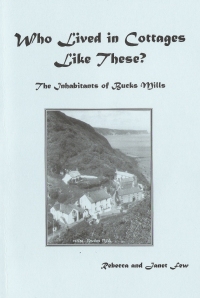 Written with Rebecca Few. A cottage by cottage residential history of the fishing hamlet of Bucks Mills. A5 84 pages, indexed and illustrated. Published by The Braund Society 2003.
Written with Rebecca Few. A cottage by cottage residential history of the fishing hamlet of Bucks Mills. A5 84 pages, indexed and illustrated. Published by The Braund Society 2003.
Available from the author £5.00 plus postage.
Before Braundsworthy: the Braund Family History 1000-1550
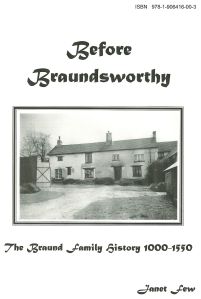 References to the Braund name before 1550. These are set in the context of the events of the time. A5 28 pages illustrated and indexed. Published by The Braund Society 2012.
References to the Braund name before 1550. These are set in the context of the events of the time. A5 28 pages illustrated and indexed. Published by The Braund Society 2012.
Available from the author.
So Soon Passeth it Away
A history of one branch of the Braund family, through 250 years. So Soon Passeth it Away was a prize winning entry in the Millennium family history competition, run by The Institute of Heraldic and Genealogical Studies. Published by The Braund Society.
Available from the author.
Volume 1 Cornish Origins
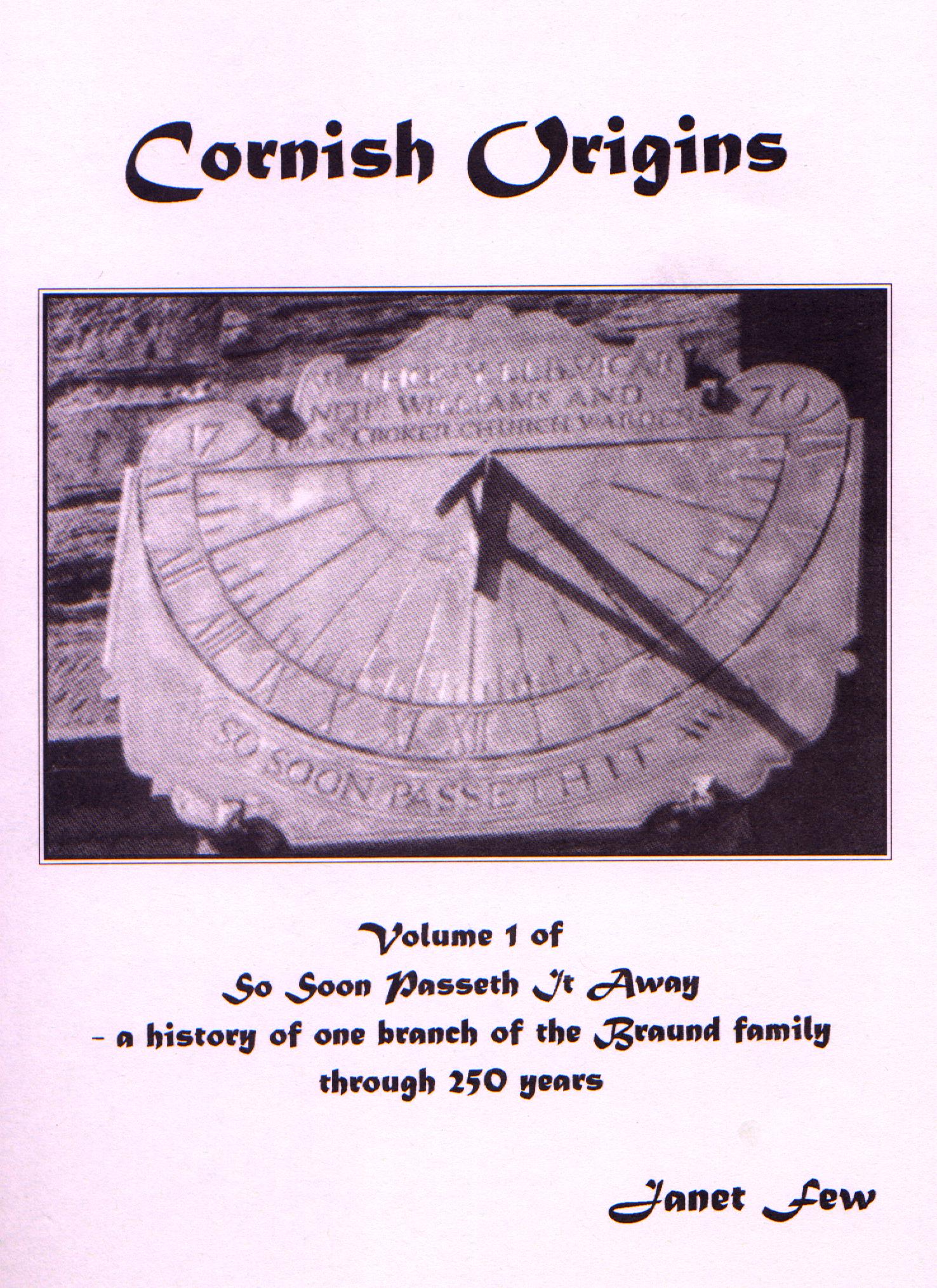
Samuel Braund was a slate carver and schoolmaster who settled in Menheniot, Cornwall. His life, work and death, possibly during an epidemic, are covered in this first publication The biographies of his children, about whom much less is known, are included here. The descendants of Samuel’s daughter take the story to the goldfields of Australia and their adventures are related in this volume. A5 52 pages. Published by The Braund Society 2001.
Available from the author, £3.50 plus postage.
Volume 2 Across the Tamar
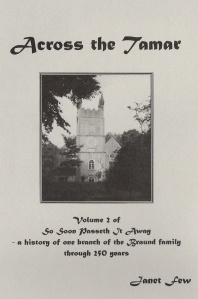 Across the Tamar’ is the second part of So Soon Passeth it Away. This volume follows a branch of the Braund family as they leave rural Cornwall, in the early years of the nineteenth century. Every attempt has been made to place the characters in their local and national historical context. Here the story of the Braunds is viewed against a background of life in the Victorian navy, work in Plymouth dockyard, emigration to America and incidents such as the cholera epidemic and the Opium Wars. This book should be of interest to those whose families share aspects of this background, as well as members of the Braund family. The book also provides a good example of how a successful family history can be written. The book is fully indexed and illustrated, with maps, photographs and family trees; a list of sources is included. A5 80 pages. Published by The Braund Society 2003.
Across the Tamar’ is the second part of So Soon Passeth it Away. This volume follows a branch of the Braund family as they leave rural Cornwall, in the early years of the nineteenth century. Every attempt has been made to place the characters in their local and national historical context. Here the story of the Braunds is viewed against a background of life in the Victorian navy, work in Plymouth dockyard, emigration to America and incidents such as the cholera epidemic and the Opium Wars. This book should be of interest to those whose families share aspects of this background, as well as members of the Braund family. The book also provides a good example of how a successful family history can be written. The book is fully indexed and illustrated, with maps, photographs and family trees; a list of sources is included. A5 80 pages. Published by The Braund Society 2003.
Available from the author, £5.00 plus postage.
Volume 3 The Cargreen Odyssey
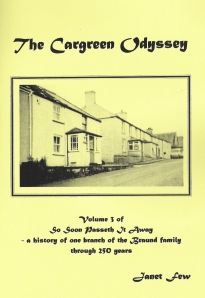 In this volume, the story turns to Samuel’s illegitimate great grandson, James Braund Jeffery, who headed the branch of the family who became shopkeepers, grocers and market gardeners on the Cornish banks of the River Tamar. The rise of James and his children to comfortable status is considered. The deaths of many members of the family from tuberculosis, or related diseases, is also discussed. A5 36 page. Published by The Braund Society 2006.
In this volume, the story turns to Samuel’s illegitimate great grandson, James Braund Jeffery, who headed the branch of the family who became shopkeepers, grocers and market gardeners on the Cornish banks of the River Tamar. The rise of James and his children to comfortable status is considered. The deaths of many members of the family from tuberculosis, or related diseases, is also discussed. A5 36 page. Published by The Braund Society 2006.
Available from the author, £3.00 plus postage.
Volume 4 In the Shadow of the Iron Horse
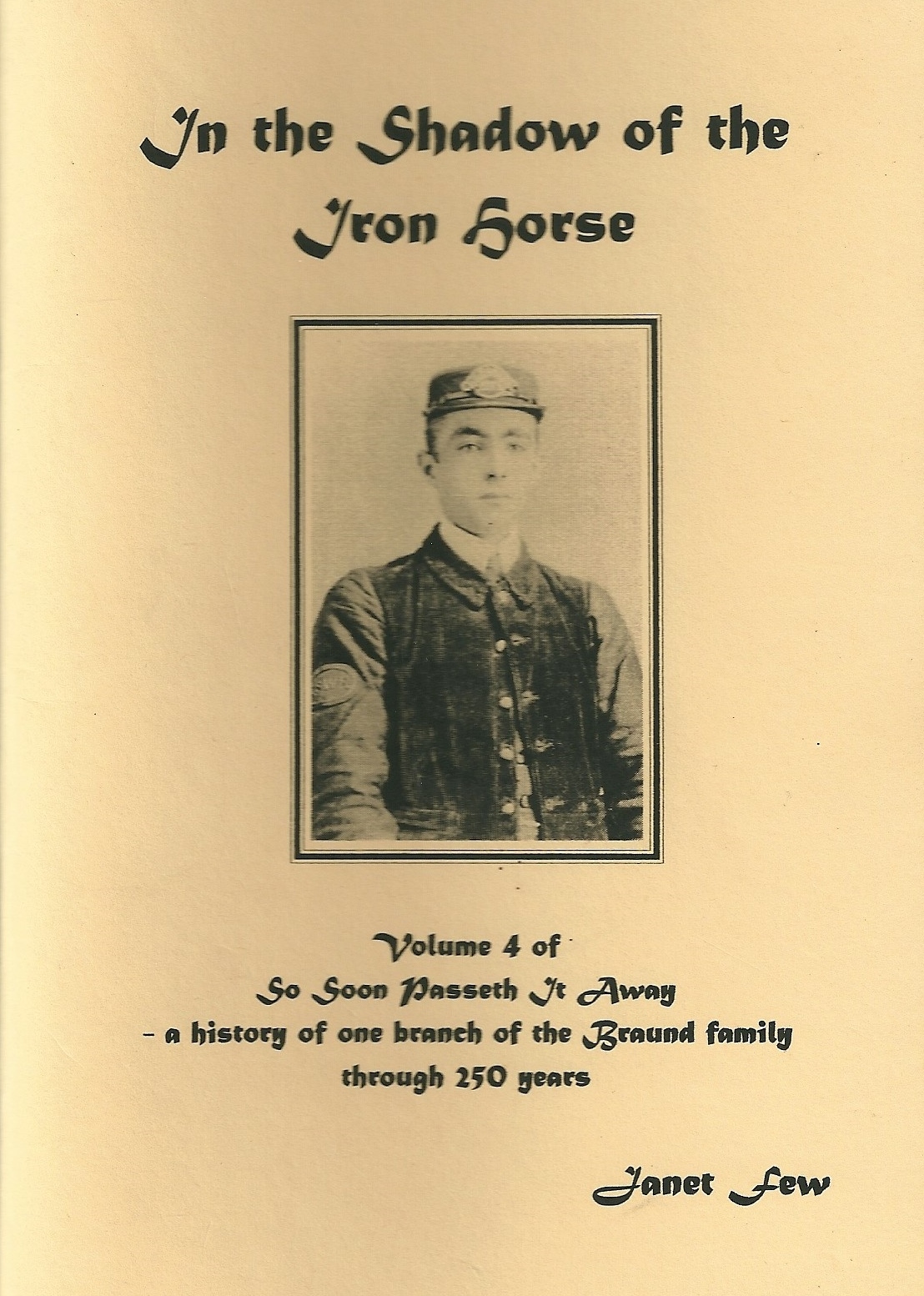
In this final volume, the narrative moves to London with Albany Braund (1888-1963), whose work on the railway took him from Plymouth at one end of the line, to Clapham Junction at the other. The account concludes with Cyril Braund, five times great grandson of Samuel and father of the author, encompassing his employment in London cinemas and his time with the Royal Air Force Regiment during the Second World War. A5 60 pages. Published by The Braund Society 2007.
Available from the author, £4.00 plus postage.
‘If men could learn from history, what lessons it might teach us!’ Coleridge
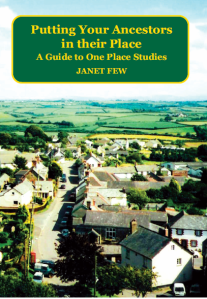
Hi Janet
I really loved the talk tonight amd would like to buy a copy of Ten Steps to a One-Place Study directly from you. Please do let me know how to do this.
With thanks,
Catherine
[…] Next, curl up on your couch with your freshly-acquired copy of Putting your Ancestors in their Place: a guide to one place studies by Dr Janet Few. Janet's currently the Chair of the Society and boy, does she know her stuff! This book was published in 2014 so is right up to date and has a ton of information and ideas about undertaking a one-place study. For more info and to order the book visit Janet’s website at https://thehistoryinterpreter.wordpress.com/publications/. […]
[…] also purchase the book Putting Your Ancestors in their Place, A Guide to One Place Studies by Janet Few. I tried to buy it from Amazon but could not. So I contacted Janet and purchased a […]
[…] are also available from the author and from Amazon (UK) […]
[…] ISBN – 9781906280437. Author’s website […]